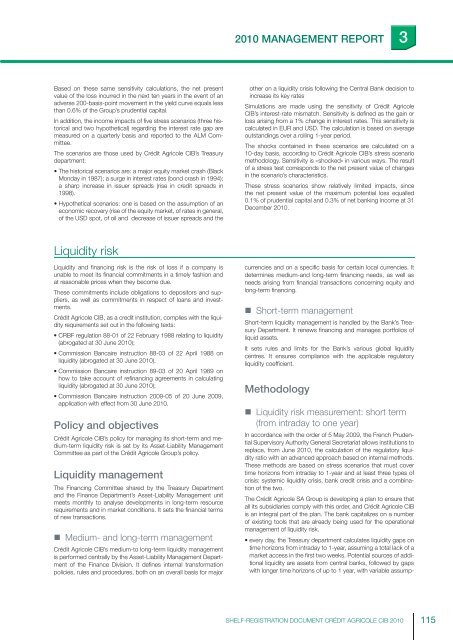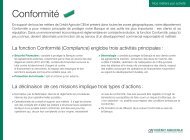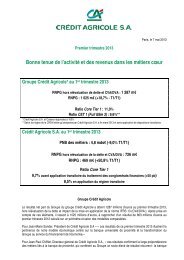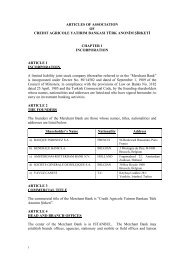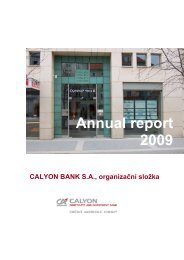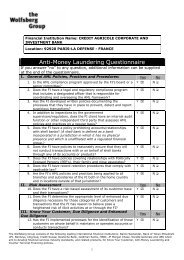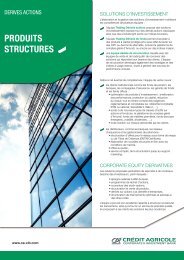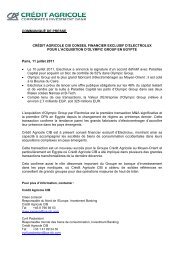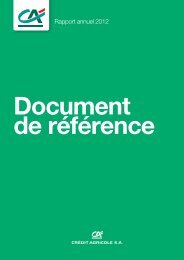ourexpertise - Crédit Agricole CIB
ourexpertise - Crédit Agricole CIB
ourexpertise - Crédit Agricole CIB
You also want an ePaper? Increase the reach of your titles
YUMPU automatically turns print PDFs into web optimized ePapers that Google loves.
2010 MANAGEMENT REPORT 3Based on these same sensitivity calculations, the net presentvalue of the loss incurred in the next ten years in the event of anadverse 200-basis-point movement in the yield curve equals lessthan 0.6% of the Group’s prudential capital.In addition, the income impacts of fi ve stress scenarios (three historicaland two hypothetical) regarding the interest rate gap aremeasured on a quarterly basis and reported to the ALM Committee.The scenarios are those used by <strong>Crédit</strong> <strong>Agricole</strong> <strong>CIB</strong>’s Treasurydepartment:• The historical scenarios are: a major equity market crash (BlackMonday in 1987); a surge in interest rates (bond crash in 1994);a sharp increase in issuer spreads (rise in credit spreads in1998).• Hypothetical scenarios: one is based on the assumption of aneconomic recovery (rise of the equity market, of rates in general,of the USD spot, of oil and decrease of issuer spreads and theother on a liquidity crisis following the Central Bank decision toincrease its key ratesSimulations are made using the sensitivity of <strong>Crédit</strong> <strong>Agricole</strong><strong>CIB</strong>’s interest-rate mismatch. Sensitivity is defi ned as the gain orloss arising from a 1% change in interest rates. This sensitivity iscalculated in EUR and USD. The calculation is based on averageoutstandings over a rolling 1-year period.The shocks contained in these scenarios are calculated on a10-day basis, according to <strong>Crédit</strong> <strong>Agricole</strong> <strong>CIB</strong>’s stress scenariomethodology. Sensitivity is « shocked« in various ways. The resultof a stress test corresponds to the net present value of changesin the scenario’s characteristics.These stress scenarios show relatively limited impacts, sincethe net present value of the maximum potential loss equalled0.1% of prudential capital and 0.3% of net banking income at 31December 2010.Liquidity riskLiquidity and fi nancing risk is the risk of loss if a company isunable to meet its fi nancial commitments in a timely fashion andat reasonable prices when they become due.These commitments include obligations to depositors and suppliers,as well as commitments in respect of loans and investments.<strong>Crédit</strong> <strong>Agricole</strong> <strong>CIB</strong>, as a credit institution, complies with the liquidityrequirements set out in the following texts:• CRBF regulation 88-01 of 22 February 1988 relating to liquidity(abrogated at 30 June 2010);• Commission Bancaire instruction 88-03 of 22 April 1988 onliquidity (abrogated at 30 June 2010),• Commission Bancaire instruction 89-03 of 20 April 1989 onhow to take account of refi nancing agreements in calculatingliquidity (abrogated at 30 June 2010);• Commission Bancaire instruction 2009-05 of 20 June 2009,application with effect from 30 June 2010.Policy and objectives<strong>Crédit</strong> <strong>Agricole</strong> <strong>CIB</strong>’s policy for managing its short-term and medium-termliquidity risk is set by its Asset-Liability ManagementCommittee as part of the <strong>Crédit</strong> <strong>Agricole</strong> Group’s policy.Liquidity managementThe Financing Committee shared by the Treasury Departmentand the Finance Department’s Asset-Liability Management unitmeets monthly to analyse developments in long-term resourcerequirements and in market conditions. It sets the fi nancial termsof new transactions.• Medium- and long-term management<strong>Crédit</strong> <strong>Agricole</strong> <strong>CIB</strong>’s medium-to long-term liquidity managementis performed centrally by the Asset-Liability Management Departmentof the Finance Division. It defi nes internal transformationpolicies, rules and procedures, both on an overall basis for majorcurrencies and on a specifi c basis for certain local currencies. Itdetermines medium-and long-term fi nancing needs, as well asneeds arising from fi nancial transactions concerning equity andlong-term fi nancing.• Short-term managementShort-term liquidity management is handled by the Bank’s TreasuryDepartment. It renews fi nancing and manages portfolios ofliquid assets.It sets rules and limits for the Bank’s various global liquiditycentres. It ensures compliance with the applicable regulatoryliquidity coeffi cient.Methodology• Liquidity risk measurement: short term(from intraday to one year)In accordance with the order of 5 May 2009, the French PrudentialSupervisory Authority General Secretariat allows institutions toreplace, from June 2010, the calculation of the regulatory liquidityratio with an advanced approach based on internal methods.These methods are based on stress scenarios that must covertime horizons from intraday to 1-year and at least three types ofcrisis: systemic liquidity crisis, bank credit crisis and a combinationof the two.The <strong>Crédit</strong> <strong>Agricole</strong> SA Group is developing a plan to ensure thatall its subsidiaries comply with this order, and <strong>Crédit</strong> <strong>Agricole</strong> <strong>CIB</strong>is an integral part of the plan. The bank capitalizes on a numberof existing tools that are already being used for the operationalmanagement of liquidity risk.• every day, the Treasury department calculates liquidity gaps ontime horizons from intraday to 1-year, assuming a total lack of amarket access in the fi rst two weeks. Potential sources of additionalliquidity are assets from central banks, followed by gapswith longer time horizons of up to 1 year, with variable assump-SHELF-REGISTRATION DOCUMENT CRÉDIT AGRICOLE <strong>CIB</strong> 2010 115


